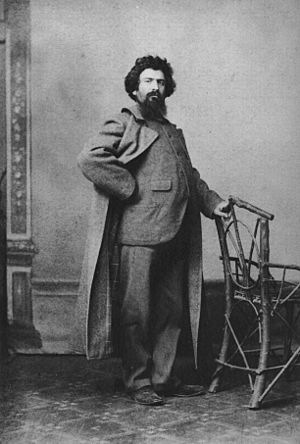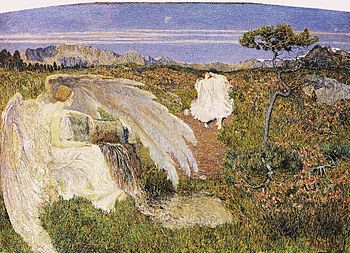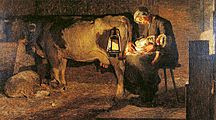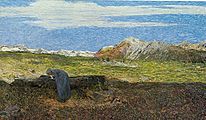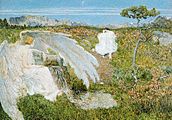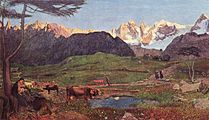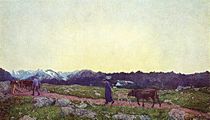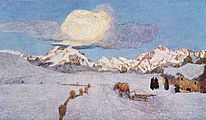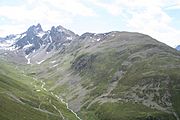Giovanni Segantini facts for kids
Quick facts for kids
Giovanni Segantini
|
|
|---|---|
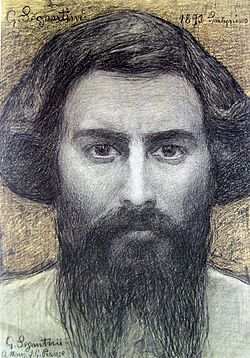
Self-portrait, 1893
|
|
| Born | 15 January 1858 Arco, Trentino, Austrian Empire
|
| Died | 28 September 1899 (aged 41) |
| Nationality | Italian |
| Education | Accademia di Brera |
|
Notable work
|
Alpine Triptych |
| Patron(s) | Vittore Grubicy de Dragon |
Giovanni Segantini (born January 15, 1858 – died September 28, 1899) was a famous Italian painter. He was known for his large paintings of mountain landscapes in the Alps. In the late 1800s, he was one of Europe's most well-known artists. Major museums bought his artworks. Later in his life, he used a painting style called Divisionism and added Symbolist ideas about nature to his art. He spent his last years living and working in Switzerland.
Contents
Biography of Giovanni Segantini
Giovanni Battista Emanuele Maria Segatini was born in Arco, Trentino. At that time, this area was part of the Austro-Hungarian Empire. He later changed his family name to Segantini.
Giovanni's early life was very hard. His mother died when he was seven. His father, a traveling salesman, died a year later. This left Giovanni an orphan. He was cared for by his older half-sister, Irene. They lived in extreme poverty.
Irene tried to move to Milan to find a better life. She tried to give up their Austrian citizenship. But she didn't complete the process to become Italian citizens. Because of this, Giovanni and Irene were stateless for their whole lives. This meant they didn't officially belong to any country. Even when Giovanni became famous, he refused offers of Swiss citizenship. He said Italy was his true home. After he died, the Swiss government made him a citizen.
When he was seven, Giovanni ran away and lived on the streets of Milan. The police sent him to a special school called the Marchiondi Reformatory. There, he learned how to make shoes. He struggled with reading and writing for many years. He finally learned these skills in his mid-30s. Luckily, a chaplain at the school noticed Giovanni's talent for drawing. He encouraged Giovanni to develop this skill.
In 1873, Giovanni's half-brother Napoleon took him from the reformatory. Napoleon ran a photography studio in Trentino. Giovanni learned the basics of photography there. He later used photography to capture scenes for his paintings.
Giovanni Segantini's Art Career
In 1874, Segantini went back to Milan. He took classes at the Brera Academy, an art school. There, he became friends with artists from a group called Scapigliatura. This group wanted to mix art with everyday life. His friends Carlo Bugatti and Emilio Longoni greatly influenced his work.
His first important painting was The Chancel of Sant Antonio. It was bought by a Milan art society in 1879. This painting caught the eye of Vittore Grubicy de Dragon, a painter and gallery owner. Grubicy became Segantini's advisor and helped him financially throughout his life. Grubicy and his brother introduced Segantini to the works of Anton Mauve and Jean-François Millet. These artists influenced Segantini's style for many years.
In the same year, he met Luigia Pierina Bugatti, known as "Bice." She was Carlo Bugatti's sister. They fell in love and stayed together for life. Segantini wanted to marry Bice, but he couldn't get the legal papers because he was stateless. So, they decided to live together without being married. This caused problems with the Catholic church. They had to move often to avoid being judged by local communities.
Even with these difficulties, Segantini loved Bice deeply. He wrote her many love letters when he was away. Sometimes he would include wild flowers he had picked. He once wrote, "Take these flowers... as a symbol of my great love."
In 1880, Segantini and Bice moved to a mountain village. There, Segantini started painting en plein air, which means painting outdoors. He preferred working outside rather than in a studio. While he painted, Bice would read to him. This helped him learn to read and write. Later, he wrote articles for art magazines and many letters to Bice and other artists.
Around this time, he painted the first version of Ave Maria. This painting won a gold medal at the 1883 World's Fair in Amsterdam. As he became more famous, Segantini made a deal with the Grubicy brothers. They would be the only ones to sell his art. This gave Segantini more freedom to paint. However, the dealers were often slow to pay him. His family struggled with money for many years. Bice gave birth to four children: Gottardo, Alberto, Mario, and Bianca. To help Bice, Segantini hired a young maid named Barbara "Baba" Uffer. Baba also became his favorite model for his paintings.
In 1886, Segantini moved his family to Savognin, Graubünden, in Switzerland. He was drawn to the beautiful mountain scenery. His art dealer, Grubicy, visited him there. Grubicy suggested that Segantini separate his colors more to make them brighter. Segantini used this advice in a second version of Ave Maria. This was his first time using the Divisionist painting technique. This new, bolder style was very popular. Segantini won gold medals for his paintings Midday in the Alps and Ploughing.

Grubicy also introduced Segantini to Symbolism. This was a new art movement that focused on ideas and emotions rather than just showing reality.
In 1890, Segantini had a whole room for his art at an exhibition in Brussels. This was a great honor, given to famous artists like Cézanne and Van Gogh. Even though he was famous in Europe, he could not attend international shows. He still couldn't get a passport because he was stateless. Frustrated, he refused to pay taxes in Savognin. After people tried to collect the taxes, he moved his family to the Engadin valley in Switzerland. The high mountains and clear light became the main subjects of his paintings for the next five years.
After moving higher into the mountains, he started studying philosophy. He read writers who thought about the meaning of life and people's place in nature. He was especially interested in Nietzsche. He even drew a picture for the first Italian translation of Nietzsche's book, Thus Spoke Zarathustra.
He met Giovanni Giacometti, an artist and the father of the famous sculptor Alberto Giacometti. Giacometti later painted Segantini on his deathbed. Segantini also corresponded with Giuseppe Pellizza da Volpedo, an Italian artist whose color techniques he admired.
Segantini continued to gain fame in Italy. In 1894, a large show of ninety of his works was held in Milan. At the first Venice Biennale in 1895, he won the Prize of the Italian State for his painting Return to the Homeland. In 1896, a whole room was dedicated to his work in Munich. Museums across Europe wanted to buy his paintings.
In 1897, Segantini was asked to create a huge painting of the Engadin valley. It was for the 1900 World's Fair in Paris. He worked mostly outdoors on very large canvases. But the project had to be made smaller due to money problems. Segantini changed his idea into a large three-part painting called a triptych. It was named Life, Nature, and Death. This is now his most famous work. He worked on it until he died.
Segantini's importance as an international artist grew. In 1899, a whole room was dedicated to his work at an exhibition in Brussels.
Eager to finish the third part of his triptych, Nature, Segantini returned to the high mountains near Schafberg. The fast pace of his work and the high altitude affected his health. In mid-September, he became very ill with a stomach infection called peritonitis. He died two weeks later. His son Mario and his partner Bice were with him.
A memorial exhibition of his works was held in Milan. In 1908, the Segantini Museum was built in St. Moritz. Its design was inspired by one of his sketches for the Engadin Panorama.
Themes in Segantini's Art
Segantini's art shows a clear change from older 19th-century art to the new styles of the 20th century. He started by painting simple scenes of everyday people like farmers and shepherds. Later, his art became more symbolic. He continued to paint landscapes but added ideas about nature and spirituality. He moved from painting small, personal scenes, like a mother in a stable, to grand views of the mountains where he lived.
Nature and how people connect to it are the main ideas in his art. After he moved to the mountains, he wrote, "I am now working passionately to find Nature's secret spirit." He believed nature spoke to artists about love and life.
His 1896 painting Love at the Fountain of Life shows his deep thoughts about art. It is set in the high mountains near his home. The painting shows an angel with large wings over a small waterfall. In the distance, two lovers walk toward the spring. Flowers around them symbolize love and life.
An art historian named Robert Rosenblum said Segantini changed "the earthly into the spiritual." Segantini himself called his work "naturalist Symbolism." He once said, "I've got God inside me. I don't need to go to church."
Gallery
Graubünden Area
There is a hiking trail that goes through areas where Segantini often painted outdoors.
See also
 In Spanish: Giovanni Segantini para niños
In Spanish: Giovanni Segantini para niños


